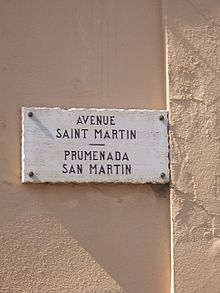
Monégasque dialect
You can help expand this article with text translated from the corresponding article in French. (January 2022) Click [show] for important translation instructions.
|
| Monégasque | |
|---|---|
| munegascu | |
| Native to | Monaco |
| Ethnicity | 8,400 have Monegasque nationality (2016)[1] |
Native speakers | (ca. 20 cited for 1950)[2] nearly extinct, but taught in school as a heritage language |
| Official status | |
Recognised minority language in | |
| Regulated by | Commission pour la Langue Monégasque |
| Language codes | |
| ISO 639-3 | – |
| Glottolog | mone1238 |
| Linguasphere | 51-AAA-cha |
| IETF | lij-MC |


Monégasque (munegascu, pronounced [muneˈɡasku]; French: monégasque, pronounced [mɔneɡask] ⓘ; Italian: monegasco) is the variety of Ligurian spoken in Monaco. It is closely related to the Ligurian dialects spoken in Ventimiglia and is considered a national language of Monaco, though it is not the official language of the country, which is French. Monégasque has been officially taught[4] in the schools of Monaco since 1972 and was made a compulsory subject in 1976,[5] but is the native language of only a handful of people.

History
In 1191, the Republic of Genoa took possession of Monaco and began settling in 1215. These Genoese settlers brought their vernacular language with them which would develop into Monégasque. Prior to the Genoese settlers, the main language of the region was Provençal, as spoken in the nearby localities of Menton and Roquebrune. By 1355, Menton, Roquebrune, and Monaco were under the political union of the Grimaldis, but despite this, there was a linguistic divide as the primary language of Monaco was Ligurian. Over time Monégasque began to split from the Genoese vernacular as Monaco came under the political influence of foreign powers, namely taking influences from French and Italian, but also briefly from Spanish and Catalan as Monaco had been under Spanish occupation for over a hundred years, ending in 1641.

Afterwards, Monaco would be under French protection and prior to the French Revolution, Italian and Monégasque were the primary languages of the political elite, administration, clergy and natives. French would however begin to become a major influence as France instituted bilingual government. At this time the population of Monaco was mainly made up of immigrants and descendants from Genoa and other parts of Liguria, and though Monégasque was not written, it was openly spoken and passed down through families by oral tradition. People coming in from the Italian city-states were considered closer neighbours than those coming in from Grimaldi-led cities of Menton and Roquebrune, who were considered foreigners despite their union with Monaco.[6]

In 1793, Monaco was annexed by France and by 1805, decrees from Napoleon, Emperor of the French, imposed French language instruction and limited the use of other languages. The Grimaldis reestablished a sovereign principality in 1814, but maintained French as the only official language though Italian and Monégasque remained national languages. In 1815, Prince Honoré IV decreed French and Italian equal status in education, though Italian gradually declined as the nearby regions became more French, noticeably in 1860 with the French annexation of Nice. Monégasque was then demoted to a "patois," and barred from being taught or spoken in public and religious schools until 1976, in a similar manner to that of Occitan in France.[7][8][9]

The first written traces of Monégasque appear between 1721 and 1729 in the correspondence of Antonio I with his daughter Louise Hippolyte, as well as in a few notarial deeds, but the language remained above all, oral. From 1860, the population of Monaco City rose from 1,200 inhabitants in 1860 to 22,000 in 1880; Monégasque found itself threatened by the massive influx of foreign workers and by the development of a pidgin mixing Provençal, Piedmontese, Corsican, French, and Ligurian. At that time, Monégasque was banned from school and parents encouraged their children to speak French. In 1927, Louis Notari undertook the written codification of the language, drawing inspiration from the writing of French and Italian. The first Monegasque grammar and dictionary appeared in 1960 and 1963.

By 1924, Monégasque was close to extinction if not for the efforts of the National Committee of Monégasque Traditions (Cumitáu Naçiunale d'ë Tradiçiúe Munegasche). In 1927, Louis Notari published the A Legenda de Santa Devota, the first literary work in Monégasque. This was soon followed by all kinds of literature, such as poetry, stories, and plays being written in Monégasque attracting more attention to the language. In 1972, the first class in Monégasque was taught by clergymen, Georges Franzi, with support from the Félibrige, an Occitan language association, and by 1976, Monégasque was made a compulsory subject in public and private primary education thanks to an initiative by the government. This was later expanded in 1979 and 1989 to make it a compulsory subject in secondary education and as an optional subject for the baccalaureate.[10] In 1982, Prince Rainier III created a sovereign ordinance that established the Commission for the Monégasque Language, which is responsible for the education and study of the language.[11][12]


Classification
Monégasque shares many features with the Genoese dialect and is closely related to the dialect of Ventimiglia. Despite earlier attempts to link it to Occitan, Monégasque is a Ligurian dialect with Occitan contributions while the nearby Menton dialect is an Occitan dialect with Ligurian features.

Monégasque, like all other Ligurian language variants, is derived directly from the Vulgar Latin of what is now northwestern Italy and southeastern France and has some influence in vocabulary, morphology and syntax from French and related Gallo-Romance languages.[13]

Speakers
The sole official language of Monaco is French as stated in its constitution with Monégasque being used informally. As Monégasques are only a minority in Monaco, the language was threatened with extinction in the 1970s. In a nation with 130 different nationalities, Monégasque struggles in a time of globalisation. Despite being compulsory in education, it is not common for students in Monaco to use it outside the classroom or to take their bachelor's degree in the Monégasque option. Adult education and lessons to foreign residents are carried out and there is an annual language competition for schoolchildren over which the Prince presides.

Literature
Beginning with Louis Notari’s A Legenda de Santa Devota. Any semblance of written Monégasque was usually referred to as Ligurian, Genoese, Italian, and sometimes even French.

Other authors in Monégasque include:

- Louis Barral, curator of the Museum of Prehistoric Anthropology, lexicographer of the Monégasque dictionary, and author of science fiction.
- Suzanne Simone, co-author of the dictionary with Barral.
- Robert Boisson, founder of the Academy of Dialectal Languages (French: Academie des languages dialectales) and poet of works such as Vibrations intérieures – Harmonies Humaines.
- Louis Frolla, clergyman and grammarian of Monégasque.
- Georges Franzi teacher of Monégasque and activist for education in Monégasque.
- Étienne Clerissi, actor, artist, and author of numerous plays in Monégasque.
- Jules Soccal, sailor and author of Le Vocabulaire monégasque de la marine et de la mer, a description of Monégasque sea jargon.
Orthography
The Monégasque alphabet comprises 23 letters: seventeen consonants and nine vowels[clarification needed], plus the letter "k" at the initial of some loanwords (such as kaki̍). "J" and "H" are never found at the beginning of a word. In Monégasque, each vowel is pronounced separately. Monégasque orthography generally follows Italian principles, with a few unique graphemes and features borrowed from French:[14]

| Letters | IPA | Digraphs |
|---|---|---|
| A | /a/ | |
| B | /b/ | |
| C | /k/ or /tʃ/ | Ch /k/ |
| Ç | /s/ | |
| D | /d/ | |
| E | /e/ | Œ /œ/, Ë /iː/ |
| F | /f/ | |
| G | /ɡ/ or /dʒ/ | Gh /g/, Gl /ʎ/ |
| H | ∅ silent | |
| I | /i/ | |
| J | /ʒ/ | |
| L | /l/ | |
| M | /m/ | |
| N | /n/ | |
| O | /o/ | |
| P | /p/ | |
| Q | /k/ | |
| R | /ɾ/ or /ʁ/ | |
| S | /s/ or /z/ or /ʃ/ | Sc /sk/ or /ʃ/, Scc /ʃtʃ/ |
| T | /t/ | |
| U | /u/ | Ü /y/ |
| V | /v/ | |
| Z | /z/ |
Notes:

- Similar to Italian hard and soft C. /k/ before a, o, u, ü, and ch.
- Similar to Italian hard and soft G. /dʒ/ before e and i.
- H is used like it is in Italian, after C and G for Ch /k/ and Gh /g/.
- Pronounced as in French, although it may be intervocalic.
- /ʃ/ before t, s, and p. /z/ in between vowels.
- /ʃ/ before e or i.
Diphthongs
| Diphthong | IPA | Example |
|---|---|---|
| ai | [aj] | aiga (water) |
| au | [aw] | auriva (olive) |
| ei | [ej] | pei (feet) |
| œi | [ej or øj] | pignœi (pine cone nuts) |
| eu | [ew] | bureu (mushroom) |
| ia | [ja] | piatu (flat) |
| ie | [je] | ientrà (to enter) |
| oi | [oj] | soi (his) |
| ou | [ow] | sou (a type of money) |
| ui | [ui] | nui (us) |
| üu | [yu] | cugiüu (mackerel) |
Grammar
| Singular | Plural | |
|---|---|---|
| 1st person | -u | -amu |
| 2nd person | -i | -è |
| 3rd person | -a | -u(n) |
| Singular | Plural | |
|---|---|---|
| 1st person | sun | semu |
| 2nd person | si | si |
| 3rd person | è | sun |
| Singular | Plural | |
|---|---|---|
| 1st person | o | amu |
| 2nd person | ai | avi |
| 3rd person | a | an |
Samples
Below is an excerpt from the Monégasque national anthem, written by Louis Notari. In addition, there is an older French version of the anthem; its lyrics have a different meaning. The choice between the two forms is generally subject to the occasion and the circumstance.

The following is a Monégasque rendering of the Hail Mary:[15]

See also
References
- ^ 2016 census
- ^ Raymond Arveiller (1967) Etude sur le Parler de Monaco. Comité National des Traditions Monégasques.
- ^ "Society". Monaco-IQ. Retrieved 6 September 2012.
- ^ L'enseignement de la Langue Monégasque (PDF), archived from the original (PDF) on 2007-10-07
- ^ "Académie des Langues Dialectales". www.ald-monaco.org. Retrieved 2022-12-11.
- ^ "Académie des Langues Dialectales". www.ald-monaco.org. Retrieved 2022-12-11.
- ^ "Académie des Langues Dialectales". www.ald-monaco.org. Retrieved 2022-12-11.
- ^ Zwierniak, Simon (2021-10-22). "The Monegasques who are keeping their language alive". Monaco Tribune. Retrieved 2022-12-11.
- ^ "Académie des Langues Dialectales". www.ald-monaco.org. Retrieved 2022-12-11.
- ^ "Académie des Langues Dialectales". www.ald-monaco.org. Retrieved 2022-12-11.
- ^ Reymond, J. (August 6, 1982). "Ordonnance Souveraine n° 7.462 du 27 Juillet 1982 portant création d'une Commission pour la Langue Monégasque" (PDF). Journal de Monaco. 6.515 (3, 50): 867.
- ^ Réunion de la Commission pour la Langue monégasque, 11 May 2017, retrieved 2022-12-13
- ^ Gubbins, Paul; Holt, Mike (2002). Beyond Boundaries: Language and Identity in Contemporary Europe. Multilingual Matters. p. 91. ISBN 978-1-85359-555-4.
- ^ Frolla, Louis (2009). Grammaire Monégasque (in French) (Rééditée ed.). Monaco: Comité National des Traditions Monégasques. pp. 1–7.
- ^ "Pater Noster in Monégasque". Archived from the original on 2008-05-09. Retrieved 2008-10-16.
External links
See what we do next...
OR
By submitting your email or phone number, you're giving mschf permission to send you email and/or recurring marketing texts. Data rates may apply. Text stop to cancel, help for help.
Success: You're subscribed now !


